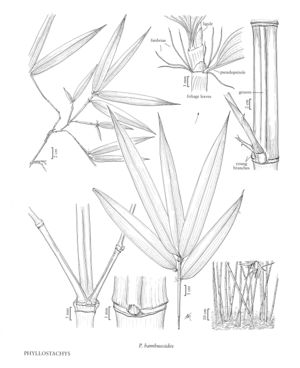Difference between revisions of "Phyllostachys bambusoides"
imported>Volume Importer |
imported>Volume Importer |
||
| (One intermediate revision by the same user not shown) | |||
| Line 39: | Line 39: | ||
|publication year= | |publication year= | ||
|special status= | |special status= | ||
| − | |source xml=https:// | + | |source xml=https://bitbucket.org/aafc-mbb/fna-data-curation/src/200273ad09963decb8fc72550212de541d86569d/coarse_grained_fna_xml/V24/V24_20.xml |
|subfamily=Poaceae subfam. Bambusoideae | |subfamily=Poaceae subfam. Bambusoideae | ||
|tribe=Poaceae tribe Bambuseae | |tribe=Poaceae tribe Bambuseae | ||
Latest revision as of 16:22, 11 May 2021
Culms to 22 m tall and 15 cm thick, erect or leaning towards the light, base sinuous in some cultivars; internodes glabrous, usually green, in cultivars golden yellow, or with yellow and green stripes, lustrous; nodal ridges usually prominent (scarcely discernible in 'Crookstem' forms); sheath scars thin, not strongly flared, glabrous. Culm leaves: sheaths glabrous or pubescent, greenish to ruddy-buff, more or less densely dark-brown-spotted; auricles absent from the basal sheaths, narrow to broadly ovate or falcate on the upper sheaths; fimbriae greenish, crinkled; ligules rounded and ciliolate to truncate and ciliate with coarse hairs; blades short, lanceolate, reflexed and crinkled on the lower leaves, those above longer and recurved, green or variously striped. Foliage leaves: auricles and fimbriae usually well developed; ligules well developed; blades to 20 cm long and 3.2 cm wide, usually puberulent to subglabrous. 2n = 48.
Distribution
Md., La., Calif., N.C., Ala., Tenn., S.C.
Discussion
Phyllostachys bambusoides, a widely cultivated species, is hardy to -17°C. Several cultivars are available, differing in the color of their culms and leaves.
Selected References
None.
